Luise Danker
Fairy tales
The work of Luise Danker (1889 Wolfhagen—1926 Kassel) is very rare and so presenting this selection is one of the very few occasions to do so. Featuring scenes from fairy tales and decorative initials, the display is a fascinating insight into the artist's printmaking skills and creative process.
The little that we know about Danker was recorded in light of a donation to the archive of the German Youth Movement in Ludwigstein Castle, Witzenhausen, made by the artist’s niece in 2016 (1). Most of her works are now kept here, and are rarely found in other private or public collections.
Danker studied at the Academy of Arts in Kassel until 1910 or 1911. She was subsequently active as a drawing teacher and ‘private’ printmaker.
In 1911 she co-founded the ‘Wandervogel’ girls’ and young women’s group in Kassel, in which she had a leading role. She was a member until 1920, at which point she joined the so-called ‘Landsgemeinde’. She was seriously injured in a fire at a community festival in Frankfurt an der Oder and died in Kassel of endocarditis (inflammation of the lining membrane of the heart), aged just 37.
The ‘Wandervogel’ was a movement founded at the end of the nineteenth century in Berlin. It was driven primarily by students from middle-class backgrounds who found themselves in a phase of increasing industrialisation and, inspired by ideals from Romanticism, turned their backs on the strict demands of their education and social milieu to develop their own way of life in the freedom of the outdoors. In this way the ‘Wandervogel’ comprised the start of the Youth Movement, which also triggered significant steps forward in progressive education, naturism and the life reform movement in the first three decades of the twentieth century. Issues surrounding the involvement of women remained controversial for a long time and led to numerous factions and new formations within the movement. Danker was one such dissident.
The ‘Wandervogel’ would become one of the largest unifiers for progressive lifestyles across the whole of Germany. Many contemporary artists joined the movement directly or were otherwise inspired by it in their work. Perhaps the best-known artist associated with the movement is the German illustrator, painter and publisher Fidus (pseudonym for Hugo Reinhold Karl Johann Höppener, 1868—1948).
Danker designed postcards for the ‘Wandervogel’, which still today are associated primarily with her name. They are visual representations of the movement and were widely circulated. They are inspired by the early work of Heinrich Vogeler. Besides Fidus, Danker was the artist most closely associated with the movement in its heyday.
(1) AdJb (Das Archiv der
deutschen Jugendbewegung auf Burg Ludwigstein), No 209.
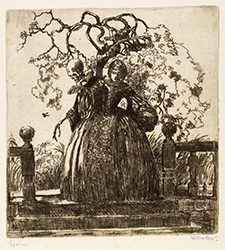
Danker, Luise
"Schatten" - Shadow
Etching in black ink.
Size of plate: 19.4 x 18.1 cm.
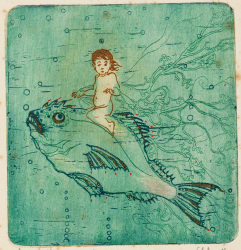
Danker, Luise
"Der auffliegende Gedanke" - The fleeting thought
Colour etching in green, blue and gold with touches of red.
Size of plate: 11.8 x 11.3 cm.
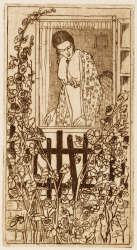
Danker, Luise
Sleeping beauty at the window
Etching in brown ink.
Size of plate: 17.2 x 9.3 cm.

Danker, Luise
"Seepferdchen" - Little seahorse
Etching and acquatint. Available in brown and in green ink.
Size of plate: 20.2 x 12.3 cm
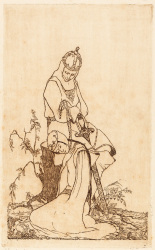
Danker, Luise
"Blaubart" - Blue beard
Etching in brown ink.
Size of plate: 22.6 x 14 cm.

Danker, Luise
"Laternenmann" - A moor holding two lamps
Lithograph on thin transparent paper.
Size of sheet: 22.5 x 15.3 cm.
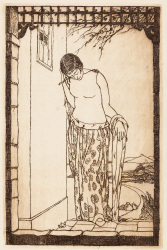
Danker, Luise
Standing beauty
Etching in brown ink.
Size of plate: 19.5 x 12.8 cm.
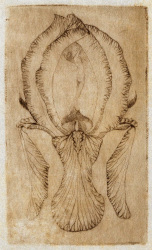
Danker, Luise
Fairy inside an iris
Etching in brown on japan paper.
Size of plate: 11.8 x 7.3 cm.